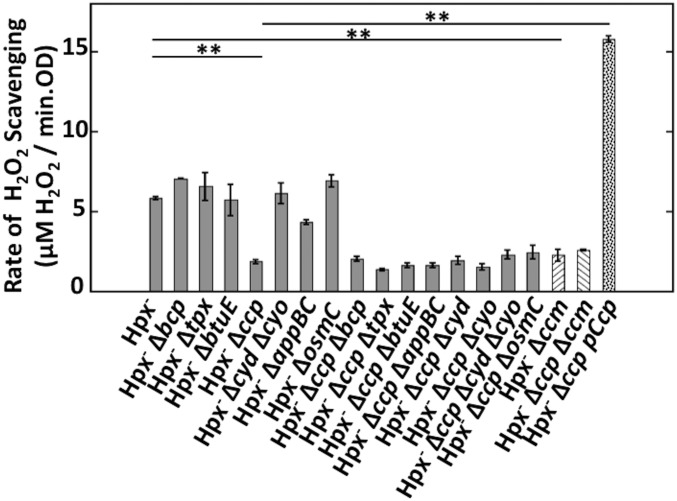Fig. 2.
Ccp scavenges H2O2 in anoxic Hpx− cells. The Hpx− parent strain and mutant derivatives were grown anaerobically, and the rate of H2O2 scavenging was measured. Cross-hatched bars: The cytochrome c maturation machinery is required for Ccp activity. Spotted bar, far right: the Hpx− Δccp mutant was genetically complemented using pACYC184-ccp under its own promoter. Asterisks represent statistical significance (*P ≤ 0.05; **P ≤ 0.01; ***P ≤ 0.001; ns, P > 0.05). The single mutants other than Hpx− Δccp and Hpx− Δccm were not significantly different from Hpx−. None of the double mutants were significantly different from Hpx− Δccp. Strains used: Hpx− (LC106), Hpx− Δbcp (MK150), Hpx− Δtpx (MK154), Hpx− ΔbtuE (MK158), Hpx− Δccp (MK146), Hpx− Δcyd Δcyo (SSK53), Hpx− ΔappBC (MK180), Hpx− ΔosmC (MK208), Hpx− Δccp Δbcp (MK172), Hpx− Δccp Δtpx (MK174), Hpx− Δccp ΔbtuE (MK176), Hpx− Δccp ΔappBC (MK182), Hpx− Δccp Δcyd (MK164), Hpx− Δccp Δcyo (MK166), Hpx− Δccp Δcyd Δcyo (MK170), Hpx− Δccp ΔosmC (MK210), Hpx− Δccm (MK198), Hpx− Δccp Δccm (MK418), and Hpx− Δccp pAcyc184-ccp (MK430).

